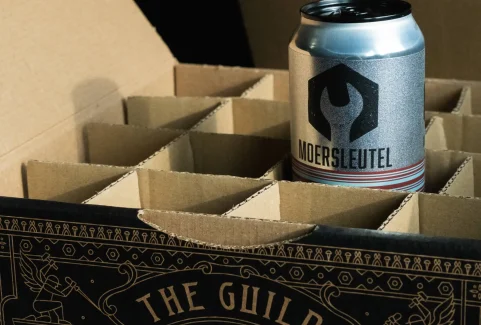Free Shipping to NL-BE-DE over € 65
Delivering Worldwide
Fast shipping: only 1-2 workdays
Are you 18 or older?
Collab with Floem: Hovercraft Freestyle
Collab day in Alkmaar, Edwin from Floem dropped by to help us brew yet another memorable beer. You know we try to make all beers special but when we’re hosting a brew with friends we try to push those beers to fully express both parties creativity. Changing the pace of our most recent New England IPAs we took a turn into something neither of us had brewed before, East Coast IPA.
This style may bring confusion to some, not as popular as other hop forward beers. In short, it was a transitional style betweetn classic American IPAs, now mostly known as West Coast IPA. East Coast IPA were, without the brewers realizing, the prototype of the NEIPA-trend. Whilst East Coast IPAs brought some fruitier notes blended with mellow caramel notes they still carried a pungent bitterness and some hop varieties that would grant resinous and piney notes. The modernized approach to hop dosing and recipe design also brought charactheristics unknown to the consumer until then, beers were now becoming hazy and turbid. And we know how all that ended.
Moersleutel is most known by its extreme, flavorful, beers. So we wondered what would mean squeezing this style to a Triple version of its own self. That’s our proposed challenge for this recipe.
Commercial Examples
Even when we’re creating something that we feel it’s completely new, the idea always has a genesis, a starting point. This doesn’t mean we’re trying to copy or do better. This means the profile of a certain beer marked one of us at some point. Since brewing is a mere reflection of our past experiences it is only sensible to look upon beers that left a mark and pay our hommage.
Two beers were fundamental in conceiving this recipe, Heady Topper from Alchemist in Vermont and Notorious ³ from Boneyard in Oregon.
Fermentables
For this style we seek a bigger malty backbone when compared to a NEIPA but a lighter sweetness and caramel presence than a classic American IPA. It means we want to preserve the nuanced biscuit and malty notes without going too extreme, especially since we’re aiming towards a Triple version, at 10% ABV.
We ended up settling on a mix base malt with a light colored Maris Otter and Golden Promise, creating a balance between efficiency, protein content and desired malty notes. Wheat malt complements with some flufiness to help sustain the high alcohol degree. Two types of oats were used, flaked and golden naked, to tweak color and grant a light haze to it. Dextrin malt closes the grain for added foam retention and a fuller mouthfeel.
During boil small amounts of simple sugars, dextrose, were added to boost the alcohol percentage and lighten the syrupy texture in such a malt-heavy recipe.
Hops
During hot side operartions, boiling and whirlpool, we added generous amounts of hops, neighbouring 10gr/L, close to dry-hop amounts. For hot side flavor we used Pink Boots blend, a hop blend conceived to help the NGO with the same name, that features notes of Citrus, Sweet Fruits and Berries. In addition to Pink Boots, during boil we also added Simcoe, a hop that mixes notes of peach, apricot and citrus with earthy notes of pine and resin.
During whirlpool, at a lower temperature to preserve aromatics, we added an extra dose of Simcoe, to make sure it’s profile gets saturated and present alongside Amarillo Cryo to layer spicy, tropical and citrus notes. We calculate the bittering level to be high on this recipe, at around 100 IBU. Expect a pungent, lingering bitter.
After fermentation finishes we’re adding the same hop varieties we used hot side, Pink Boots, Amarillo and Simcoe. We do a first dry-hop with Pink Boots and a kiss of Simcoe. After a few days of extraction, imparting all those flavors, we do an extra dose of cryogenated lupulin pellets right before packaging to capture the pungent aromatics of Amarillo and Simcoe avoid as much plant material as possible to deliver the freshest hop punget we can deliver.
Yeast
The choice was easy, we looked at our inspiratations and choose the yeast the marked the East Coast style IPA. A vermont-style yeast, with a similar profile to NE IPA yeast strains but with a higher level of attenuation and a more balanced profile.
Cheers,
Jorge Tomé – Head Brewer at Moersleutel Craft Brewery
Read more

Moersleutel bierproeverij – samen proeven & ontdekken met IPA en Stout
Samen proeven & ontdekken – dat is waar een Moersleutel bierproeverij om draait. Of je nu een doorgewinterde craftbierfan bent of net begint aan je ontdekkingsreis, met onze kenmerkende IPA’s...
